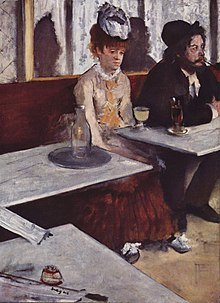Café de la Nouvelle Athens
The Café de la Nouvelle Athènes was a café in Paris . It had been at 9 Place Pigalle in the 9th arrondissement since 1855 . In the second half of the 19th century, numerous well-known artists met here. Well-known painters of the time chose the café as a motif for their pictures.
history
The name Nouvelle-Athènes
Nouvelle-Athènes ( New Athens ) was named after the district of the same name, which is located around today's metro station Saint-Georges and is bordered by Rue Clichy, Rue Châteaudun, Rue des Martyrs and Boulevard de Clichy. The area previously consisting of fields and orchards developed between 1820 and 1850 into an area with garden bars and other amusement facilities. Based on a Greek fashion set in France by the Greek War of Independence in 1821 , the district was named Nouvelle-Athènes by the journalist Dureau de la Malle in an article in the Journal des Débats of October 18, 1823 . The Café de la Nouvelle Athènes , on the other hand, did not open until 1855.
Famous guests
During the Second Empire , opposition politicians such as Léon Gambetta , writers such as Jules Castagnary , Alfred Delvau and Édmond Duranty , but also artist friends such as the painter Gustave Courbet or the photographer Nadar, increasingly met in the Café de la Nouvelle Athènes . After the Franco-Prussian War , writers such as Stéphane Mallarmé , Émile Zola , Paul Verlaine , Guy de Maupassant , Auguste de Villiers de L'Isle-Adam and Joris-Karl Huysmans were among the café's guests. From the mid-1870s, the impressionist painters switched from Café Guerbois to Café de la Nouvelle Athènes , although the audience was not completely identical. Édmond Duranty, who was friends with Edgar Degas and Édouard Manet , may have been just as decisive here as the painter Marcellin Desboutin , who did not like the Guerbois environment and preferred the quieter Café de la Nouvelle Athènes . For Manet, the café was conveniently located on the daily commute from his apartment on Boulevard des Batignolles and his studio on Rue Guyon. Pierre-Auguste Renoir's apartment was also in the nearby Rue St. Georges.
His friends Jean-Louis Forain , Jean-François Raffaëlli and Federico Zandomeneghi followed suit around Degas . In addition to Henri Guérard , Claude Monet and Camille Pissarro occasionally stopped by when they were in Paris. Paul Cézanne appeared less often, usually accompanied by the musician Ernest Cabaner . In the 1880s, painters like Vincent van Gogh , Georges Seurat , Paul Gauguin , Henri de Toulouse-Lautrec and later Henri Matisse and the musicians Erik Satie and Maurice Ravel followed in the Café de la Nouvelle Athènes .
The café as a motif for the artists
The café served as a motif for many of the painters present for their pictures. These pictures, however, were created in the respective studios and only preliminary drawings were made on site. The Irish writer George Moore , himself a regular guest at the café from the late 1870s, noted about a portrait that Manet wanted to paint of him in the café: “He initially planned to paint me in a café; he had met me in a café and thought he could reproduce the impression. ”In his memoirs, Moore cited the confessions of a young man who Manet owned a marble table in his studio that resembled those of Nouvelle Athènes and on which he ended up portrayed. Likewise, Manet's portrait of Alphonse Maureau (Art Institute of Chicago) and the well-known picture The Plum were not created in the café, but in the studio. The model for this was Edgar Degas' painting Absinthe from 1876, which Marcellin Desboutin shows with the actress Ellen Andrée in the Café de la Nouvelle Athènes . His pastel Femme dans un café (private collection) is also located in this café. Other painters who chose the café as a motif were Jean-Louis Forain and Federico Zandomeneghi.
The end of the cafe
The time as a meeting place for artists ended at the end of the 19th century when other bars on Montmartre took on this role. The restaurant changed its name several times. First it was called Monico and New Monico , before it was used as a Bricktop’s during the Second World War, first for the German occupation troops and then as a nightclub for the armies of the liberators. In the 1950s, the rooms were used by the strip club Le Sphinx . This was followed by an intermezzo as Narcisse , before the lesbian bar New Moon welcomed its guests here in the 1970s . After the building had closed in the meantime, it reopened in 1987 as New Moon and, as a rock café, primarily offered a venue for punk musicians. After the New Moon closed , the Le Temple bar moved into the building before it was destroyed in a fire in 2004. The completely burned-out building was then completely renovated and in 2007 a bar and a restaurant, again under the name Nouvelle Athènes , opened. Apart from the name and address, this establishment has nothing in common with the Café de la Nouvelle Athènes, which was founded more than 150 years earlier .
literature
- Bruno Centorame, Béatrice de Andia: La nouvelle Athènes . Action Artistique de la Ville de Paris, Paris 2001, ISBN 2-913246-33-8 .
- John Rewald: The History of Impressionism. 7th edition. DuMont, Cologne 2001, ISBN 3-7701-5561-0 .
- Jean Tiberi: La Nouvelle Athènes: Paris, capitale de l'esprit . Sand, Paris 1992, ISBN 2-7107-0480-3 .
Individual evidence
- ^ Réunion des Musées Nationaux Paris and Metropolitan Museum of Art New York (ed.): Manet . Frölich and Kaufmann, Berlin 1984, page 424, ISBN 3-88725-092-3 .
Web links
Coordinates: 48 ° 52 ′ 55.5 " N , 2 ° 20 ′ 15.9" E






